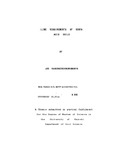| dc.description.abstract | Four buffer methods were evaluated using
Ca(OH)2~titration to pH 6.5 and CaC03~incubation
to pH 6.0 and 5.5 as reference methods and using
26 soils representing major agricultural acid soils
in Kenya. The buffer methods selected were Shoemaker
- McLean - Pratt single buffer method (SMP-SB),
Shoemaker - McLean - Pratt double buffer (SMP-DB) ,
Mehlich I (for crops with high lime requirements)
and Mehlich II (for crops with low lime requirements).
Exchange acidity (Ace), residual acidity (Acr) and
total acidity (Act) were also correlated with lime
requirements measured by the four buffer methods to
pH 6 . 5 , 6.0 and 5 . 5 . The offeet of lime on nodulation
of beans and growth of maize and beans were also
studied in the greenhouse using three selected
soils.
The lime lequirement values measured by the
reference methods to pll 6 . 5 , 6.0 and 5 . 5 were well
correlated with the values measured by the four
buffer methods. The lime requirement values measured
by the four buffer methods were also well correlated
with amounts of exchangeable aluminium, exchange
acidity, residual acidity, total acidity and organic
carbon. The SMP-DB method gave the highest correlation
coefficient values with the reference methods,
the least variations from the ideal lines, and was
(vii)
particularly impressive at lower pH target ( 5 . 5 ).
The sensitivity of the SMP-DB and SMP-SB methods
was, however, comparable for soils of high and low
lime requirements, while the sensitivity of Mehlich
methods was only adequate for soils of low and intermediate
lime requirements. All the soil acidity
components were well correlated with lime requirements
measured by the buffer and reference methods to pH
6 . 5 , 6.0 and 5 . 5 . None of the buffer methods gave
a significantly higher correlation coefficient for
any of the acidity components than the other methods.
There was an improvement in correlation coefficients
when a multiple regression using exchange acidity
and residual acidity was used over simple regression
using exchange acidity, residual acidity or total
acidity alone. In the greenhouse experiment the
highest dry matter yield was obtained at pH 5.9, 5.7 and 5.8 in
National Agricultural Laboratory (NAL), Mariene and Gituarriba soils
respectively, while the highest nodulation of beans
was obtained at pH 5 . 9 , 5.7 and 5 . 5 in NAL,
Mariene and Gituamba soils, respectively. There
was a decline in dry matter yield of maize and beans
and nodule production of beans at pH levels beyond
these. At these pH levels, exchangeable aluminium
and manganese were essentially zero.
It was concluded that liming of these soils
to achieve pH 5 . 5 to 6.0 would be ideal. Overliming
of the soils to high pH levels is likely to cause
(viii)
a nutrient imbalance resulting in a decline in yields.
Response of maize and beans to lime on NAL soil with
virtually no exchangeable aluminium indicates that
exchangeable aluminium would not be a good criterion
for liming these soils. Since it might not
be necessary to lime these soils to pH levels higher
than 6 . 0 , the performance of SMP-DB method at lower
pH targets would make it the best choice. Besides
its sensitivity over the entire lime requirement
range, the SMP-DB method has the added advantage
over the SMP-SB method of not requiring established
tables. Thus any pll target can be selected. | en_US |



